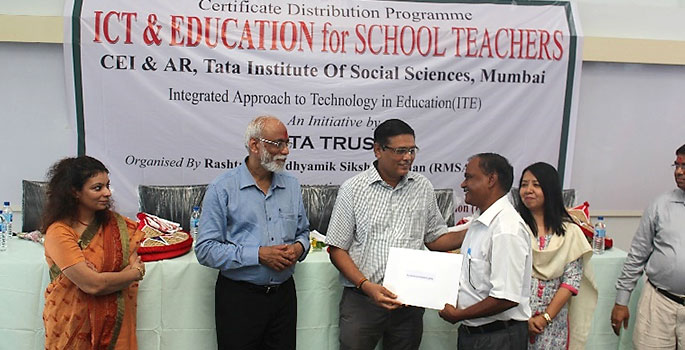
The introduction of Information and Communication Technology (ICT) in education has been a pathbreaking move by the Government of India. It has been in practice for over a decade now. However, the implementation of ICT needs further push for both teachers and students in order to make meaningful use of technology in the classroom. This can facilitate better learning for students and enhance their critical thinking and knowledge construction. ICT is an enabler for self-motivated learners as it is solution-oriented, deals with real life scenarios, and allows for flexibility in assessment.
Teachers are considered to be the heart of the ITE model. Keeping this in mind, Tata Trusts, under their ITE programme, have launched an initiative for teachers’ capacity building. The idea is to integrate digital technologies into the curriculum and instructional plans of teachers in government schools and other learning centres. In ITE, students are the producers of their own knowledge and not merely consumers of technology resources prepared for them.
The initiative seeks to improve teaching and learning processes and foster authentic and project-based learning for older children and adolescents in some of the most underprivileged geographies of India. It is a pedagogic framework that integrates ICT with the existing curriculum. The professional development of teachers is central to this approach, which is offered by the Centre for Education on Innovation and Action Research (CEI & AR) at Tata Institute of Social Sciences (TISS). Here, teachers get to decide the ICT applications, how students will creatively develop a learning artefact, and when and how to integrate open educational resources and other ICT tools in their teaching.

Under the programme, a four-month certification course in ICT & Education is offered to the teachers for their continuous professional development. The course follows a blended module with face-to-face, online, distance, and implementation modes. Post certification, the teachers are classified as master trainers who further help train other teachers. As part of the certification course, the teachers are required to handhold 12 to 15 teachers in their neighborhood schools. This increases the reach of the initiative even in the remotest of the places, thereby bringing in more teachers and students under its umbrella. Since its inception in 2012, the programme has reached out to over 1,900 teachers and 33,000 students in eight states across India.
Ms. Nabina Bardhan is an assistant teacher from West Bengal, who has successfully completed her certification course. She teaches History in Baghbazar High School in Kolkata, West Bengal. Sharing her experience, she says, “I teach a subject which does not excite most of the students. To keep them interested, I sometimes take help of teaching aids like models, maps, etc. But I think the introduction of ICT model has made it very helpful for the students in their self-learning. My students of grade 10 recently made a wonderful project on the United Nations Organisation (UNO) with a lot of enthusiasm. They found out the six main organs of UNO and their roles, objective and which are the countries involved and so on. It is a totally different experience as the students are actively involved in the learning process which greatly enriches them. They are now gathering information beyond their textbooks”.
During the certification course, the teachers get an opportunity to explore major concepts and engage in hands-on experience with various ICT tools. The resource materials given in the form of documents, videos and artefacts help in connecting concepts like 21st Century skills, national and international standards, frameworks, taxonomies, etc. As part of the course, the teachers are required to make one lesson plan each. After approval of the same by the TISS team, they implement it among their students. It is certainly a unique experience for all participants to engage with online learning platforms.
As shared by Mr. Samsul Huda, an assistant teacher at a government school in Assam, “I have attended many trainings earlier. Those trainings were good but the learning never got implemented. However, with the ICT training, implementation happens on its own. It requires you to get engaged completely. I did not even know how to handle a laptop on the first day. By second day, I was completely involved. We made individual and group projects and presented them. It was very motivating for me to get appreciated by experts for my conceptual understanding in the lesson plans”.
This course is just the beginning of the journey. It is an attempt to instil the spirit of Continuous Teacher Professional Development (CTPD) using blended teaching and learning pedagogies.

My students of grade 10 recently made a wonderful project on the United Nations Organisation (UNO) with a lot of enthusiasm.”
— Nabina Bardhan, Assistant Teacher, West Bengal
